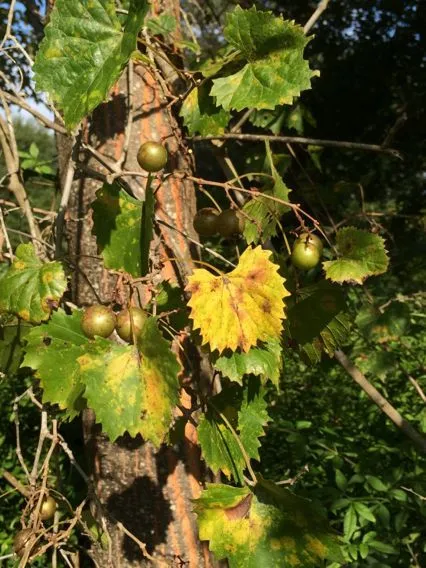
Author: Michx.
Bibliography: Fl. Bor.-Amer. 2: 231 (1803)
Year: 1803
Status: accepted
Rank: species
Genus: Vitis
Vegetable: False
Observations: C. & E. U.S.A. to Mexico
The Muscadine grape, scientifically known as Vitis rotundifolia, is an indigenous grape species native to the southeastern United States, stretching from the central and eastern parts of the country down to Mexico. Described first in authoritative botanical literature by Michx. in 1803, the Muscadine grape has since been a significant player in both natural ecosystems and agricultural landscapes within its range.
Belonging to the family Vitaceae, this species is well-adapted to the warm, humid climate characteristic of its native regions. Muscadine grapes thrive in the varied temperate climate of the southeastern U.S., showcasing great resilience to pests, diseases, and environmental stresses compared to many other grape species.
Muscadine grapes are identifiable by their thick-skinned, spherical berries that range in color from dark purple to black; however, some variations bear bronze or greenish-yellow fruits. The fruits are typically smaller and have a distinctive, robust flavor that sets them apart from common table grapes. The vines are known for their vigorous growth and can be found clinging to tree canopies in the wild or cultivated in vineyards.
These grapes serve not only as a food source but also play an integral role in local cultural practices. Historically, they have been used to produce wines, jellies, and juices, celebrated for their high antioxidant content and unique flavor profile. Their rich composition of nutrients, particularly antioxidants, vitamins, and minerals, contributes to their reputation for supporting overall health and wellness.
Botanically, the Muscadine grapevine is also notable for its distinctive leaves, which exhibit a rounder shape compared to other grape species. This morphology aids in the identification and classification of the grapevine among botanists and viticulturists alike.
Beyond their agricultural value, Muscadine grapes are significant in maintaining local biodiversity. They offer habitat and food for various species of wildlife, contributing to the ecological balance within their native regions.
In conclusion, the Muscadine grape (Vitis rotundifolia) is a distinctive and robust member of the Vitaceae family, treasured both in natural habitats and human cultivation for its hardiness, unique flavor, and nutritional benefits. Its presence from the southeastern U.S. to Mexico underscores its adaptability and significance across a broad geographic range.
Deu: muscadinerebe
Spa: moscada, vite moscata
Eng: muscadine, muscadine grape, southern fox grape
Fra: vigne musquée
En: Muscadine grape, Southern fox grape, Muscadine, American Muscadine
Ar: كرمة دائرية الأوراق
Zh: 圓葉葡萄
Fr: Vigne musquée, Vigne à feuilles rondes
De: Muscadinerebe
Ko: 둥근잎머루
Es: Moscada, Vite moscata
Taken Aug 6, 2021 by Jade Rose (cc-by-sa)
Taken May 7, 2022 by Inquiring Intellect (cc-by-sa)
Taken Sep 3, 2019 by Sharlene Lefebvre (cc-by-sa)
Taken Jul 2, 2019 by adam michael (cc-by-sa)
Taken Nov 25, 2021 by robles mario (cc-by-sa)
Taken Feb 5, 2015 by EOL − James W. Beck (cc-by-nc)
Taken Sep 13, 2013 by EOL − carolcummings (cc-by-nc)
Taken Jan 1, 1900 by EOL − USDA NRCS Wetland Science Institute. (public)
Taken Aug 13, 2019 by Green Vicki (cc-by-sa)
Taken Jul 2, 2019 by adam michael (cc-by-sa)
Taken Apr 26, 2020 by James T (cc-by-sa)
Taken Jun 18, 2020 by Madison Goretoy (cc-by-sa)
Taken May 16, 2022 by Michael Blazer (cc-by-sa)
Taken Sep 2, 2020 by Megan Malarcher (cc-by-sa)
Taken Mar 29, 2022 by Maarten Vanhove (cc-by-sa)
Taken Sep 15, 2014 by EOL − Laura Clark (cc-by-nc)
Taken Sep 22, 2021 by Isabelle Boyel (cc-by-sa)
Taken Jul 31, 2020 by zio_dave (cc-by-sa)
Taken Mar 29, 2022 by Maarten Vanhove (cc-by-sa)
Taken Oct 28, 2022 by augustin (cc-by-sa)
Taken May 15, 2021 by Matt Miller (cc-by-sa)
Taken Jun 5, 2021 by Matt Miller (cc-by-sa)
Taken Jun 7, 2019 by B Elsa (cc-by-sa)
Taken Jun 3, 2019 by Bruce Winter (cc-by-sa)
Taken Jun 24, 2015 by EOL − Melissa McMasters (cc-by)
Taken Jul 8, 2022 by Krzysztof Golucki (cc-by-sa)
Taken Aug 17, 2019 by Jean-Daniel BLARD (cc-by-sa)
Taken Aug 17, 2019 by Jean-Daniel BLARD (cc-by-sa)
Growth form: Multiple Stem
Growth habit: Vine
Growth rate: Moderate
Ph maximum: 8.0
Ph minimum: 6.0
Family: Myrtaceae Author: (F.Muell.) K.D.Hill & L.A.S.Johnson Bibliography: Telopea 6: 402 (1995) Year: 1995 Status:…
Family: Rubiaceae Author: Pierre ex A.Froehner Bibliography: Notizbl. Bot. Gart. Berlin-Dahlem 1: 237 (1897) Year:…
Family: Sapindaceae Author: Koidz. Bibliography: J. Coll. Sci. Imp. Univ. Tokyo 32(1): 38 (1911) Year:…
Family: Asteraceae Author: A.Gray Bibliography: Pacif. Railr. Rep.: 107 (1857) Year: 1857 Status: accepted Rank:…
Family: Fabaceae Author: Medik. Bibliography: Vorles. Churpfälz. Phys.-Ökon. Ges. 2: 398 (1787) Year: 1787 Status:…
Family: Aspleniaceae Author: (Cav.) Alston Bibliography: Bull. Misc. Inform. Kew 1932: 309 (1932) Year: 1932…